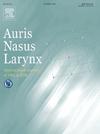GJB2变异的法因戈尔德综合征。
IF 1.5
4区 医学
Q2 OTORHINOLARYNGOLOGY
引用次数: 0
摘要
先天性听力损失是最常见的出生缺陷,遗传因素涉及50%的语前病例。GJB2变异导致高达50%的常染色体隐性非综合征性听力损失,通常表现出稳定的听力特征和良好的人工耳蜗(CI)结果。然而,在这个病例中,非典型的临床过程促使进一步的评估。一名3- 6个月大的女婴,在35周出生,通过听觉脑干反应检测出严重的双侧听力损失。患者鼓膜正常,耳呈角状,小头畸形,身材矮小,睑裂狭窄,指端异常。CT显示内耳畸形包括双侧前庭增大和耳蜗神经管狭窄。基因检测显示为GJB2 c.235delC (p.L79fs)纯合子变异。最初的助听器被证明不够,导致植入CI,这提高了听力阈值。语言和社交方面的滞后依然存在。由于她的姐姐没有GJB2变异,有听力损失和特征性身体症状的家族史,进一步的遗传分析显示MYCN杂合变异(NM_005378:c.1138_1139del:p.S380fs),确认为1型法因戈尔德综合征(FS1)。本报告是一个非常罕见的FS 1合并GJB2变异引起的严重听力损失的报告。GJB2未检测到的畸形的早期筛查导致了准确的诊断和向家庭提供信息。本文章由计算机程序翻译,如有差异,请以英文原文为准。
Feingold syndrome with GJB2 variants
Congenital hearing loss is the most common birth defect, with genetic factors implicated in 50 % of prelingual cases. GJB2 variant, causing up to 50 % of autosomal recessive non-syndromic hearing loss, typically show stable hearing profiles and favorable cochlear implant (CI) outcomes. In this case, however, the atypical clinical course prompted further evaluation. A 3-year-6-month-old girl, born at 35 weeks presented with profound bilateral hearing loss detected by auditory brainstem response. The patient had normal tympanic membranes, angulated ears, microcephaly, short stature, narrow palpebral fissures, and digital anomalies. CT revealed inner ear malformations including bilateral vestibular enlargement and cochlear nerve canal stenosis. Genetic testing showed a homozygous GJB2 c.235delC (p.L79fs) variant. Initial hearing aids proved insufficient, leading to CI placement, which improved hearing thresholds. Language and social delays persisted. As her older sister, without a GJB2 variant, had hearing loss and a family history of characteristic physical symptoms, further genetic analysis revealed a heterozygous MYCN variant (NM_005378:c.1138_1139del:p.S380fs), confirming Feingold syndrome type 1 (FS1). This report is a very rare report of FS 1 combined with severe hearing loss due to a GJB2 variant. Early screening for malformations not detected by GJB2 led to accurate diagnosis and provision of information to the family.
求助全文
通过发布文献求助,成功后即可免费获取论文全文。
去求助
来源期刊

Auris Nasus Larynx
医学-耳鼻喉科学
CiteScore
3.40
自引率
5.90%
发文量
169
审稿时长
30 days
期刊介绍:
The international journal Auris Nasus Larynx provides the opportunity for rapid, carefully reviewed publications concerning the fundamental and clinical aspects of otorhinolaryngology and related fields. This includes otology, neurotology, bronchoesophagology, laryngology, rhinology, allergology, head and neck medicine and oncologic surgery, maxillofacial and plastic surgery, audiology, speech science.
Original papers, short communications and original case reports can be submitted. Reviews on recent developments are invited regularly and Letters to the Editor commenting on papers or any aspect of Auris Nasus Larynx are welcomed.
Founded in 1973 and previously published by the Society for Promotion of International Otorhinolaryngology, the journal is now the official English-language journal of the Oto-Rhino-Laryngological Society of Japan, Inc. The aim of its new international Editorial Board is to make Auris Nasus Larynx an international forum for high quality research and clinical sciences.
 求助内容:
求助内容: 应助结果提醒方式:
应助结果提醒方式:


